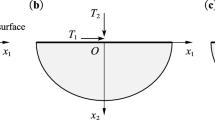Abstract
A computer code based on the use of the surface integral method, which represents a crack as a distribution of force dipoles, has been developed for modeling 3D nonplanar fractures. The nonplanar geometry was approximated as piecewise linear by subdividing the fracture surface into triangular elements that assume constant crack opening in the interior, and a p 1/2 variation of opening along the crack front. The resulting singular integral equations were integrated using a combination of numerical and analytical techniques.
Convergence studies using the surface integral formulation have yielded accurate stress intensity factors and crack opening displacements for both planar and nonplanar cracks under a variety of mixed mode loading conditions. Elliptical meshes were mapped on to cylindrical and spherical surfaces to model nonplanar fractures that could be compared to published results. Also, a high aspect ratio rectangular mesh was used to model a nonplanar kinked crack under plane strain conditions.
Similar content being viewed by others
References
M.K.Kassir and G.C.Sih, Mechanics of Fracture, Vol 2-Three-Dimensional Crack Problems, Noordhoff International Publishing, Leyden (1975).
I.S.Raju and J.C.Newman, Stress-intensity factors for a wide range of semi-elliptical surface cracks in finite thickness plates, Engineering Fracture Mechanics 11 (1979) 817–829.
R.T. Fenner and F. Nadiri, Boundary element treatment of three-dimensional elastic fracture mechanics problems, presented at the ASME conference on Advanced Topics in Boundary Element Analysis, Miami Beach, Florida (1985) see AMD 72 (1985).
G.E.Blandford, A.R.Ingraffia and J.A.Liggett, Two dimensional stress intensity factor computations using the boundary element method, International Journal of Numerical Engineering 17 (1981) 387–404.
Y.Mi and M.H.Aliabadi, Dual boundary element method for three-dimensional crack growth analysis, Boundary Element XV 2 (1993) 249–260.
J.R. Rice, First-order variation in elastic fields due to variation in location of a planar crack front, Journal of Applied Mechanics 52, No 3 (1985).
T.L. Sham, A unified finite element method for determining weight functions in two and three dimensions, Department of Mechanical Engineering, Aeronautical Engineering and Mechanics, Rensselear Polytechnic Institute, October (1985).
M.P.Cleary, Fundamental solutions for a fluid-saturated porous solid, International Journal of Solids and Structures 13 (1977) 785–806.
V.M.Narendran and M.P.Cleary, Elastic interaction of multiple arbitrary shaped cracks in plane inhomogeneous regions, Engineering Fracture Mechanics 19, 3 (1984) 481–506.
B.S. Annigeri, Surface Integral Finite Element Hybrid Method for Localized Problems in Continuum Mechanics, Sc.D. thesis in the Department of Mechanical Engineering, M.I.T., April (1984).
W.D. Keat, Surface Integral and Finite Element Hybrid Method for the Analysis of Three-Dimensional Fractures, Department of Mechanical Engineering, Massachusetts Institute of Technology, April (1989).
A.R.Ingraffia, in Rock Fracture Mechanics, H.P.Rossmanith (ed.), Springer-Verlag, New York (1983) 151–208.
A.E.H.Love, A Treatise on the Mathematical Theory of Elasticity, Dover Publications, New York (1944).
C.E.Pearson, Handbook of Applied Mathematics, Van Nostrand Reinhold Company, New York (1983).
I.N.Sneddon, The distribution of stress in the neighborhood of a crack in an elastic solid, Proceedings of the Royal Society of London, Ser A 187 (1946) 229–260.
W.D.Collins, Some axially symmetric stress distributions in elastic solids containing penny-shaped cracks, I. Cracks in an infinite solid and thick plate, Proceedings of the Royal Society of London, Ser A 266 (1962) 359–386.
V.Sladek and J.Sladek, Three-dimensional curved crack in an elastic body, International Journal of Solids and Structures 19 (1983) 425–436.
H.Abe, K.Hayashi and M.Kiko, Stress intensity factors for a cylindrically curved elliptical crack, Transactions of the Japanese Society of Mechanical Engineers 50–455 (1984) 1367–1375.
H.Abe, K.Hayashi and T.Yamamoto, Growth Path of a Crack in Earth's Crust, Transactions of the Japanese Society of Mechanical Engineers 51–465 (1985) 1359–1366.
Author information
Authors and Affiliations
Rights and permissions
About this article
Cite this article
Forth, S.C., Keat, W.D. Three-dimensional nonplanar fracture model using the surface integral method. Int J Fract 77, 243–262 (1996). https://doi.org/10.1007/BF00018780
Received:
Accepted:
Issue Date:
DOI: https://doi.org/10.1007/BF00018780




